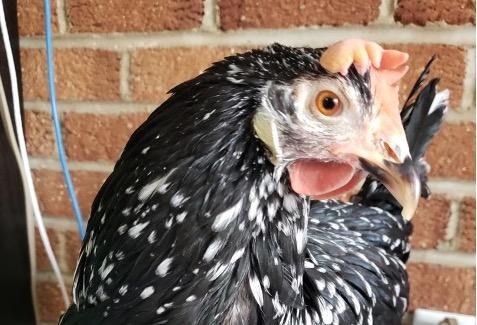-
About
- Leadership & Faculty
- News & Events
-
Academics
- Graduate
- Advanced Clinical Training
- Continuing Education
- Academic Departments
- Academic Offices
- Simulation Experiences
-
Student Life
- Offices
-
Research
-
Hospitals & Clinics
- Emergency Care
- Hospital Services
-
Community Outreach
- Volunteer
Clinical Case Challenge: Chicken with Distended Coelom
Penguin the chicken with an uncommon diagnosis

A four-year-old Ancona chicken named Penguin presented to Henry and Lois Foster Hospital for Small Animals with a distended and firm coelom that appeared to be painful when palpated. The chicken’s coelom had gradually become more distended for over a year. She also had a severely reduced appetite.
History
Penguin initially presented at Foster Hospital at three years old with a distended coelom. Her owner is a veterinarian (and graduate of Cummings School of Veterinary Medicine) and noticed its distension and firmness, and that the chicken was “more aggressive and antsy,” according to Julianne Richard, D.V.M., Zoological Companion Animal Medicine (ZCAM) resident at Cummings School.
An ultrasound of her coelom was performed, and nothing abnormal was observed. Over the next year, Penguin’s owner noted her coelom continued to enlarge and was possibly uncomfortable, but the chicken was eating, drinking, and otherwise behaving normally.
When Penguin returned next to the Foster Hospital, she was 4 ½ years old. Her appetite had decreased over several weeks prior to presentation, at first only eating favorite items, such as peanuts, but not her typical foods. Eventually, her owner began gavage feeding Penguin a liquid diet, as she no longer ate on her own.
Penguin’s coelom was massively distended, and it appeared painful when palpated. Penguin’s owner had conducted bloodwork at her clinic which showed anemia (hematocrit of 28%). The owner had also performed a barium study which did not show any overt evidence of gastrointestinal obstruction. She added gastrointestinal prokinetic medications in an attempt to improve her appetite, an anti-inflammatory medication, and vitamin K to prevent bleeding in case the anemia was from the blood not clotting properly.
Can you solve this case?
Determine which additional diagnostics and treatments are required
- An ultrasound revealed a significant and progressive amount of fat in the coelom from her last coelomic ultrasound, as the chicken was not eating well and losing weight. No other abnormalities were identified. The owner was instructed to continue gavage feedings, medications, and recheck in two weeks.
Two weeks later, Penguin still was not eating well. The doctors palpated a soft tissue mass on the left side of her crop which had not been identified previously. The owner requested surgery for the chicken—both to remove this structure and to explore her coelom, given the continued discomfort and distension. A CT scan was offered prior to the surgical exploration, but the owner declined. The surgeries were staged, with the procedure to explore the area around her crop performed first.
- In surgery, a very large, fat-filled structure was found wrapped around/outside the left side of the chicken’s crop, which was removed.
- The fat-filled structure was submitted for histopathology and found to be a lipoma.
When Penguin returned to Foster Hospital two weeks later, she had started eating small amounts on her own and was perkier. Her owner continued expressing a desire to explore her coelom. Additional surgery was scheduled.
- During the second surgery, a midline incision was made in the chicken’s coelom and revealed a huge mass of fat—so much so no organs were visible in the coelom.
- There was a significant number of adhesions from the fat to the underlying organs, so the surgeons broke down the adhesions slowly with Q-tips and LigaSure. The adhesions could explain Penguin’s discomfort on coelomic palpation.
- A mass of fat was removed that had taken up approximately 70% of the coelom.
- A small amount of fat under the keel could not be removed due to the surgeons’ inability to access it.
- The coelomic organs were compressed dorsally by the fat but appeared unremarkable, except for the liver, which looked pale.
- A small piece of liver was biopsied and determined to represent hepatic lipidosis.
- The mass of fat was also submitted for histopathology and was consistent with another lipoma.
- Penguin recovered well. The owner expressed concern over Penguin’s pale comb and wattle upon discharge from Foster Hospital, and she was progressively anemic. However, no internal bleeding post-operatively was noted on a repeat ultrasound. Penguin spent several more days in a different hospital receiving supportive care.
According to Richard, “Penguin is now doing great. She’s back to her normal self, eating ravenously again. She’s like a new chicken.” Penguin’s owner will continue to monitor the chicken at her veterinary clinic.
Comments from Cummings School’s ZCAM Team
“Adhesions of fat tissues in chickens are not commonly reported,” said Richard. “The adhesions were a surprise. The fat was so big and kept growing and sticking to other organs. It’s not common, or maybe we just don’t see it often because coelomic surgeries—aside from reproductive tract surgeries—are not commonly performed in chickens.”
Richard added, “Bird surgery is very difficult [and requires considerable skill]. Blood loss can be significant and air sacs may have to be ruptured, so it’s a risky procedure, especially with us not knowing the cause of Penguin’s issue fully prior to surgery. The owner had faith and wanted to do what was best and relieve the discomfort. The owner has another chicken, so we collected blood from that chicken as a blood donor in case we needed blood in surgery. We didn’t use it, but it was good to have a back-up plan in case we couldn’t control the bleeding.”
Department:
Foster Hospital for Small Animals